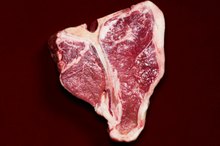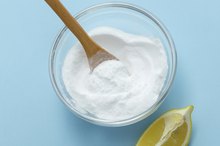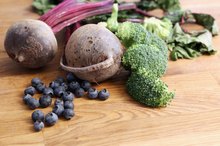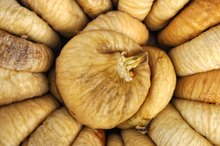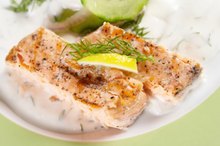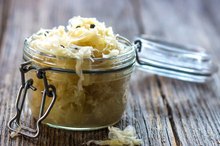What does fact checked mean?
At Healthfully, we strive to deliver objective content that is accurate and up-to-date. Our team periodically reviews articles in order to ensure content quality. The sources cited below consist of evidence from peer-reviewed journals, prominent medical organizations, academic associations, and government data.
The information contained on this site is for informational purposes only, and should not be used as a substitute for the advice of a professional health care provider. Please check with the appropriate physician regarding health questions and concerns. Although we strive to deliver accurate and up-to-date information, no guarantee to that effect is made.
Acid Forming Foods Vs. Alkaline Forming Foods
Humans eat a variety of foods that are classified as acidic or alkaline. Acidic foods are defined as foods that increase acid waste products in your blood. Alkaline foods are foods that produce ash that neutralizes acid products in your blood. Holistic practitioners believe that disease arises from consuming too many acidic or alkaline foods and throws the pH of the body into chaos, according to naturopathic doctor Christopher Vasey 1. Christopher Vasey maintains that the human body works to maintain a pH level between 7.36 and 7.42 in order for enzymes, nutrients and minerals to function properly.
Importance
Felicia Drury Kliment, an alternative health consultant, writes in her book “The Acid-Alkaline Balance” that the Western diet is filled with foods that raise acid levels in the body and leave behind acid wastes for the liver, skin and kidneys to neutralize and excrete 13. Drury Kliment asserts that acid levels in the body rise due to overconsumption of animal proteins, dairy products, processed foods and sugars this leads to a high level of acids which causes metabolic changes. The lungs and kidneys will compensate for above normal acid levels, but if an underlying disease is present these organ systems can be altered, according to Audrey Ensminger, adjunct professor at California State University-Fresno in “Food and Nutrition Encyclopedia. 2"
Types
PH & Weight Loss
Learn More
Foods are classified as acidic or alkaline based on the ash produced after they are eaten. According to Audrey Ensminger, foods are classified as acidic or alkaline by the mineral content left behind from the metabolism. Acid-promoting diets can be prescribed for patients with kidney stones, as it is believed the stones were produced under alkaline conditions in the body, as stated by Audrey Ensminger. Before starting this type of diet, consult with your healthcare provider as you may increase your risk of compromising your nutritional and health status. According to Ingrid Kohlstadt in “Food and Nutrients in Disease Management,” the popular Mediterranean diet that is used to manage cholesterol abnormalities is an alkaline diet 4. The Mediterranean diet has been recommended by the American Heart Association to lower cholesterol levels and lower risks of heart disease 5. The Mediterranean diet is rich in fruits, vegetables, whole grains, olive oil, beans, seeds, nuts and limits meat, dairy, sugar and processed foods.
- Foods are classified as acidic or alkaline based on the ash produced after they are eaten.
- Acid-promoting diets can be prescribed for patients with kidney stones, as it is believed the stones were produced under alkaline conditions in the body, as stated by Audrey Ensminger.
Alkaline Foods
Vegetables and fruits are alkaline foods because the ash left behind is rich in potassium, sodium, calcium and magnesium, according to Audrey Ensminger. Many citrus fruits are alkaline because when your body uses them for energy, they leave behind potassium, which has an alkaline effect on your blood.
Acidic Foods
An Alkaline Diet & Baking Soda
Learn More
Proteins such as meat, fish, poultry and dairy products are acidic in nature because they are rich in choline, phosphorus and sulfur. In addition, proteins are broken down into amino acids that can produce sulfuric acid, as stated by Audrey Ensminger. Grains and cereals are also acid-forming foods. Phytates in grains bind phosphorus, leaving it unavailable to raise pH levels in the blood. This is the main reason why grains are considered acid-forming foods.
- Proteins such as meat, fish, poultry and dairy products are acidic in nature because they are rich in choline, phosphorus and sulfur.
- In addition, proteins are broken down into amino acids that can produce sulfuric acid, as stated by Audrey Ensminger.
Acid and Calcium
Acid and alkaline foods are both essential to sustain life. Writing in “The Acid-Alkaline Diet for Optimum Health,” Christopher Vasey states that food rich in sulfur, sodium, phosphorus, chlorine, iodine and silicon increase the acidic qualities of foods 1. When a person eats foods rich in these minerals, their levels will increase in the blood. The bones will release calcium to neutralize these minerals in order to decrease the acid level in the blood. The use of calcium for this purpose could possibly lead to osteoporosis -- porous bones – if a person's diet remains high in acid foods for long periods. Calcium is an alkaline mineral of which dairy products contain high amounts. The body excretes excess calcium in the stool, which decreases the alkalinity of dairy products and changes it to an acid. According to Audrey Ensminger, many foods that may taste acidic or alkaline are not when they are metabolized or binding elements in the food that alter their pH effect on the body.
- Acid and alkaline foods are both essential to sustain life.
- When a person eats foods rich in these minerals, their levels will increase in the blood.
Related Articles
References
- "The Acid-Alkaline Diet for Optimum Health"; Christopher Vasey, N.D.; 1999
- "Food and Nutrition Encyclopedia, Vol 1"; Audrey Ensminger; 1994
- "The Acid-Alkaline Balance Diet"; Felicia Drury Kliment; 2002
- "Food and Nutrients in Disease Management"; Ingrid Kohlstadt; 2009
- American Heart Association: Mediterranean Diet
- The Telegraph, "Cleanse your body with the alkaline diet." Dec. 29, 2014
- Han H, Segal AM, Seifter JL, Dwyer JT. Nutritional Management of Kidney Stones (Nephrolithiasis). Clin Nutr Res. 2015;4(3):137-52. DOI: 10.7762/cnr.2015.4.3.137
- Schwalfenberg GK. The alkaline diet: is there evidence that an alkaline pH diet benefits health?. J Environ Public Health. 2012;2012:727630. DOI:10.1155/2012/727630
- Remer, T et al. Potential Renal Acid Load of Foods and its Influence on Urine pH, Journal of the American Dietetic Association, Volume 95, Issue 7, 791 - 797 DOI:10.1016/S0002-8223(95)00219-7
- Dawson-Hughes B, Harris SS, Ceglia L. Alkaline diets favor lean tissue mass in older adults. Am J Clin Nutr. 2008;87(3):662-5. doi: 10.1093/ajcn/87.3.662
- Fagherazzi G, Vilier A, Bonnet F, et al. Dietary acid load and risk of type 2 diabetes: the E3N-EPIC cohort study. Diabetologia. 2014;57(2):313-20. doi:10.1007/s00125-013-3100-0
- Xu H, Åkesson A, Orsini N, Håkansson N, Wolk A, Carrero JJ. Modest U-Shaped Association between Dietary Acid Load and Risk of All-Cause and Cardiovascular Mortality in Adults. J Nutr. 2016;146(8):1580-5. doi:10.3945/jn.116.231019
- Han E, Kim G, Hong N, et al. Association between dietary acid load and the risk of cardiovascular disease: nationwide surveys (KNHANES 2008-2011). Cardiovasc Diabetol. 2016;15(1):122. doi:10.1186/s12933-016-0436-z
- Jia T, Byberg L, Lindholm B, et al. Dietary acid load, kidney function, osteoporosis, and risk of fractures in elderly men and women. Osteoporos Int. 2015;26(2):563-70. doi:10.1007/s00198-014-2888-x
- Rebholz CM, Coresh J, Grams ME, et al. Dietary Acid Load and Incident Chronic Kidney Disease: Results from the ARIC Study. Am J Nephrol. 2015;42(6):427-35. doi:10.1159/000443746
Writer Bio
Cydney Walker is a registered dietitian and personal trainer who began writing about nutrition and exercise during her dietetic internship in 2000. She has been featured in "Voices" and by the National Medical Association for her HIV research. She earned her master's degree in human sciences from Texas A&M University in Kingsville.
